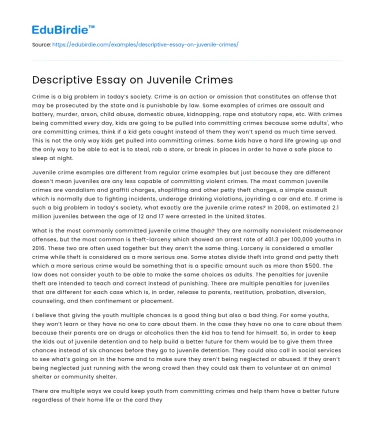Crime is a big problem in today’s society. Crime is an action or omission that constitutes an offense that may be prosecuted by the state and is punishable by law. Some examples of crimes are assault and battery, murder, arson, child abuse, domestic abuse, kidnapping, rape and statutory rape, etc. With crimes being committed every day, kids are going to be pulled into committing crimes because some adults', who are committing crimes, think if a kid gets caught instead of them they won’t spend as much time served. This is not the only way kids get pulled into committing crimes. Some kids have a hard life growing up and the only way to be able to eat is to steal, rob a store, or break in places in order to have a safe place to sleep at night.
Juvenile crime examples are different from regular crime examples but just because they are different doesn’t mean juveniles are any less capable of committing violent crimes. The most common juvenile crimes are vandalism and graffiti charges, shoplifting and other petty theft charges, a simple assault which is normally due to fighting incidents, underage drinking violations, joyriding a car and etc. If crime is such a big problem in today’s society, what exactly are the juvenile crime rates? In 2008, an estimated 2.1 million juveniles between the age of 12 and 17 were arrested in the United States.
Save your time!
We can take care of your essay
- Proper editing and formatting
- Free revision, title page, and bibliography
- Flexible prices and money-back guarantee
What is the most commonly committed juvenile crime though? They are normally nonviolent misdemeanor offenses, but the most common is theft-larceny which showed an arrest rate of 401.3 per 100,000 youths in 2016. These two are often used together but they aren’t the same thing. Larceny is considered a smaller crime while theft is considered as a more serious one. Some states divide theft into grand and petty theft which a more serious crime would be something that is a specific amount such as more than $500. The law does not consider youth to be able to make the same choices as adults. The penalties for juvenile theft are intended to teach and correct instead of punishing. There are multiple penalties for juveniles that are different for each case which is, in order, release to parents, restitution, probation, diversion, counseling, and then confinement or placement.
I believe that giving the youth multiple chances is a good thing but also a bad thing. For some youths, they won’t learn or they have no one to care about them. In the case they have no one to care about them because their parents are on drugs or alcoholics then the kid has to fend for himself. So, in order to keep the kids out of juvenile detention and to help build a better future for them would be to give them three chances instead of six chances before they go to juvenile detention. They could also call in social services to see what’s going on in the home and to make sure they aren’t being neglected or abused. If they aren’t being neglected just running with the wrong crowd then they could ask them to volunteer at an animal shelter or community shelter.
There are multiple ways we could keep youth from committing crimes and help them have a better future regardless of their home life or the card they have been dealt. A simple gesture or going out of your way to help the youth is a step in the right direction.






 Stuck on your essay?
Stuck on your essay?

